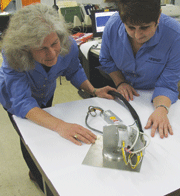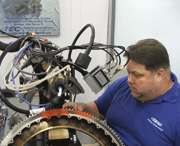E-Archive
Interview
in Vol. 10 - March Issue - Year 2009
Manufacturing X-Ray Diffraction Systems

Beth Matlock (left) and Donna Mullaly contemplate possibilities

Tony Johnson sets up sample

Kevin Roper (left) and Eric Merritt discuss measurements

Alice Loy (left) and Kelli Wolfe confer on a report
MFN had the chance to talk to Beth Matlock, Senior Materials Scientist of TEC/Material Testing Div., a company based in the U.S.A.
(?) MFN: Who is TEC, and what do you do?
(!) B. M.: TEC is a small, high technology company that has made a significant impact on the global industrial market. We consist of four divisions - ACES, Nuclear, Powermetrix and Materials Testing. ACES, our aviation group, uses vibration and acoustic analysis for balancing and engine trend monitoring. The Nuclear Division offers a group of on-line monitoring products for commercial nuclear power plants which includes valve flow monitoring, loose parts monitoring, and electrical signal isolators. Powermetrix provides field testing equipment designed to help electric utilities find lost revenue. The Materials Testing Division supplies products and services for residual stress and retained austenite measurement.
(?) MFN: You work for the Materials Testing Division, so tell me what you do.
(!) B. M.: We provide X-ray diffraction products and services for measuring residual stresses and retained austenite. We work with our customers to understand their needs. Some customers know exactly what they need in the way of residual stress and/or retained austenite measurements. For those that don't, we take the time to understand the specific problems or objectives each customer has. In some cases, we make measurements in stages in order to optimize the results with a minimum number of measurements. We also work with our products customers to help them select options that will allow them to make measurements on the shape, size and materials they encounter.
Once the measurements are complete we are available to discuss all aspects of the results. In other words, we work closely with our customers to help them understand the results and meet their objectives. Over the years we've developed great working relationships with a number of companies.
We support our products customers by keeping their systems running, making our knowledge base available to them and generally assisting and consulting with them on special projects. Our first products customer, Redstone Arsenal, is still using their original 1610 system. They upgraded their capabilities by purchasing a 4000 system. I think this speaks volumes about the durability and quality of the systems we produce.
(?) MFN: You mention the systems at Redstone Arsenal. What systems are available from TEC?
(!) B. M.: Our first system, the 1600 Series, was developed in the early 80s. They were based on the ground breaking work performed by Professor Jerry Cohen and Dr. Michael James at Northwestern University. During the development, TEC had a technology exchange with Caterpillar and later, Timken. An application laboratory was set up at TEC to test the new systems and explore new applications.
In the late '90s and early 2000s TEC developed the 4000 system. This system was designed to capitalize on the strengths of the 1600 systems in a smaller more versatile package. The 4000 is available in a one-or two-detector version that can be operated in omega or psi orientations. It is automated such that the operator simply places the sample under the x-ray tube and presses start on the computer. The 4000 has a large selection of x-ray tubes and probably the most complete selection of peak-fitting routines.
MAX, miniature apparatus for x-ray diffraction, is our latest system. It was developed under an SBIR program to make residual stress measurements in hard to access locations on aircraft. This system is a two-detector system that uses the single exposure technique. It makes measurements in 2 to 3 minutes. MAX comes in two briefcase-sized cases, so it is very portable. The measurement head fits inside a 6" orifice.
(?) MFN: How have x-ray diffraction residual stress measurements systems improved?
(!) B. M.: We've come along way since the first x-ray diffraction stress measurement was made in the mid-1920s. Back then, you would cut a quarter-sized plug from your sample, send it to the lab and wait about 8 hours to get a result. Of course the sectioning destroyed your part and probably relaxed the stresses you were trying to measure.
In the late '50s/early '60s GM Tech Center developed a "portable" system called Fastress to measure stress in aluminum and steel alloys and to measure retained austenite. This system greatly improved measurement times and reduced the need for sectioning. With the advent of the position-sensitive detector, truly portable systems could be built and measurement times were reduced to a few minutes.
TEC started building position-sensitive detectors in the '70s and adapted them to x-ray diffraction systems in the early '80s. Our applications lab, and later our services lab, have contributed to the advancement of this technique through our applied research and development. Now we can measure stress in most engineering materials in a matter of minutes without sectioning the parts. We also go out in the field when the part is too large to come to the laboratory.
We can also tell a lot about the part in addition to the stress state. For example we can assess grain size, preferred orientation and plastic strain. These metallurgical and mechanical factors help us to see the big picture about a part, which in turn, allows us to better solve the puzzle for our customers.
(?) MFN: Who are your customers?
(!) B. M.: We are especially active in the aerospace and automotive industries, but we don't want to limit ourselves. We provide services and products to the bearing, agricultural equipment, materials, medical, heavy machinery, transportation and structures industries. We also work with universities and research organizations. In the past few years, we've seen an interest in processing and/or surface enhancement technologies. We've characterized residual stresses for shot peened, laser shock peened, and ultrasonic impact treatment samples. In other words, anyone who can benefit from residual stress and retained austenite measurements will be given our time, expertise, and assistance to solve their materials concerns.
(?) MFN: How can residual stress services or equipment solve problems for your customers performing shot peening?
(!) B. M.: TEC can depth profile to determine if the peening was done correctly. X-ray diffraction is an excellent comparison tool, and we use it to show how changes in peening parameters affect the elastic and plastic strains. We recently presented a paper with the Army Research Lab that showed we could predict the relative effective shot peening depth using the surface residual stress and peak width information.
(?) MFN: What are some applications and what value can your services and products add for your customers?
(!) B. M.: Any time you plastically deform a part you change the residual stress. This means that manufacturing, processing and using a component has the potential for changing the stress state. Because residual stresses can be beneficial, introducing these beneficial stresses during manufacturing or processing can mean the difference between a part that lasts and premature failure.
Residual stresses have become very important over the last 20 years as companies have redesigned parts out of new materials or reduced size and weight for energy savings. We're asking for longer life while reducing mass. Again, beneficial residual stresses are required to get the performance necessary in a competitive economy. Residual stresses are an important component of designing with new materials. TEC's service and products can provide the information needed to validate these new materials.
In the manufacturing process of steels, retained austenite may also be an important consideration. Retained austenite levels are generally associated with the alloy selected and thermal processing. Improper retained austenite levels affect performance and may result in costly failures. We measure retained austenite in bearings among other things. If you're in an airplane with improperly heat treated bearings, you may not have as many landings as you have take-offs. Of course, this is an extreme example of the effects of improper retained austenite levels. When we make retained austenite measurements, we measure two separate martensite/ferrite and two separate austenite peaks in accordance with ASTM E975 and SAE SP-453. This method is critical for accurately determining the amount of retained austenite.
As far as value is concerned, our products and services help companies efficiently produce parts that should perform properly and last a normal lifetime. When you convert this into dollars, your return on investment may mean the difference between profit and loss.
(?) MFN: What differentiates TEC from its competitors?
(!) B. M.: TEC has been actively involved in portable x-ray diffraction systems since 1980. Since then we have developed a reputation for providing reliable equipment that produce precise results. We have listened to our customers to provide systems and services that meet their needs. We take customer support seriously and try to exceed their expectations in supporting their systems or working with them on measurement programs. TEC has ISO 9001:2000 certification and our Materials Testing Lab is accredited by A2LA and certified to guide ISO 17025. We put emphasis on quality, and we strongly believe in providing value to our customers.
MFN would like to thank Beth Matlock for this interview!
For Information:
TEC/Materials Testing Division
10737 Lexington Drive
Knoxville, TN 37932 USA
Tel. +1.865.966.5856
Fax +1.865.675.1241
E-mail: info@tecstress.com
www.tecstress.com




























